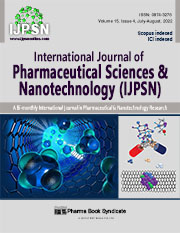Formulation and Evaluation of Naproxen Orodispersible Tablets
DOI:
https://doi.org/10.37285/ijpsn.2022.15.4.5Abstract
Background: In the treatment of variant disease, oral administration is the main choice in society, especially in children. Orodispersible tablets have been more popular among children in recent years than oral liquid dosage forms. An Orodispersible tablet disintegrates in the oral cavity and the drug gives pharmacological and therapeutically responses as the faster onset of action.
Purpose of the study: Naproxen is a nonsteroidal anti-inflammatory drug that is used to treat mild to moderate pain and arthritis. In this study, super disintegrant agents Crospovidone and Croscarmellose Sodium were used to make Naproxen orodispersible tablets utilizing a direct compression approach.
Research rationale: The goal of this study was to develop and evaluate orodispersible naproxen tablets in order to improve their disintegration and dissolving profiles.
Method: Direct compression techniques were used to manufacture naproxen orodispersible tablets, which disintegrate in the oral cavity without the need for water in a matter of seconds when placed on the tongue.
Results: FTIR and PXRD were used to investigate the drug-excipient interaction. The pre-compression and post-compression properties of the prepared tablets were assessed. The formulated tablets show a disintegration time of 32-53 seconds with In vitro drug release of 100% within 15 minutes. Weight variation, Friability, and Hardness were all found to be within acceptable limits.
Conclusions: Naproxen orodispersible tablets containing croscarmellose sodium, crospovidone, and other excipients provide improved disintegration and a more complete drug release profile.
Downloads
Metrics
Keywords:
Orodispersible tablets, Naproxen, Super disintegrants, Disintegration time, DissolutionDownloads
Published
How to Cite
Issue
Section
References
Abdelbary G, Prinderre P, Eouani C, Joachim J, Reynier JP and Piccerelle (2004). The utilization of a hydrophilic waxy binder in the preparation of orally disintegrating tablets by means of two different granulation methods. Bulletin of Pharmaceutical Sciences 27(1):41-51.
Davies MM and Anderson KE (1997). Clinical Pharmacokinetics of Naproxen. Clin Pharmacokinet 32(4):268-293.
Dorfman RI (1975). Chemistry and Pharmacology of naproxen., Arzneimittelforschung 25(2A): 278-281.
Ilhan E, Ugurlu T and Kerimoglu O (2017). Mini Tablets: A Short Review-Revision, Open journal of chemistry. Journal of Medicinal Chemistry Research 3(1):12-22.
Jesmeen T and Uddin R (2011). Orodispersible Tablets: A short review. Stamford Journal of Pharmaceutical Sciences 4(1): 96-99.
Joshi R, Garud N and Akram W (2020). Fast dissolving tablets: a review. International Journal of Pharmaceutical Sciences and Research 11(4):1562-1570.
Katona G (1972). Naproxen - a new non-steroidal antirheumatic in the treatment of degenerative joint disease. 211-215.
Roszkowski AP, Rooks WH, Tomolonis AJ and Miller LM (1971). Antiinflammatory and analgetic properties of d-2 (6’-methoxy-2’-naphthylp)r opionic acid (naproxen). Journal of Pharmacology and Experimental Therapeutics 179(1):114-123.
Sastry SV, Nyshadham JR and Joseph A (2000). Recent technological advances in oral drug delivery – a review. Pharmaceutical Sciences and Technology Today 3(4):138-145.
Sharma N, Pahuja S and Sharma N (2019). Immediate release tablets: a review. International Journal of Pharmaceutical Sciences and Research 10(8):3607-3618.
Slavkova M and Breitkreutz J (2015). Orodispersible drug formulations for children and elderly. European Journal of Pharmaceutical Sciences 75:2-9.
Stoltenberg I and Breitkreutz J (2011). Orally disintegrating mini-tablets- a novel solid oral dosage form for paediatric use. European Journal of Biopharmaceutics 78(3):462-9.
Tiwari S and Mahapatra SP (2020). Unit dosages form tablet: an overview, International Research Journal of Humanities, Engineering & Pharmaceutical Sciences. 5; 1(9):8-30.






